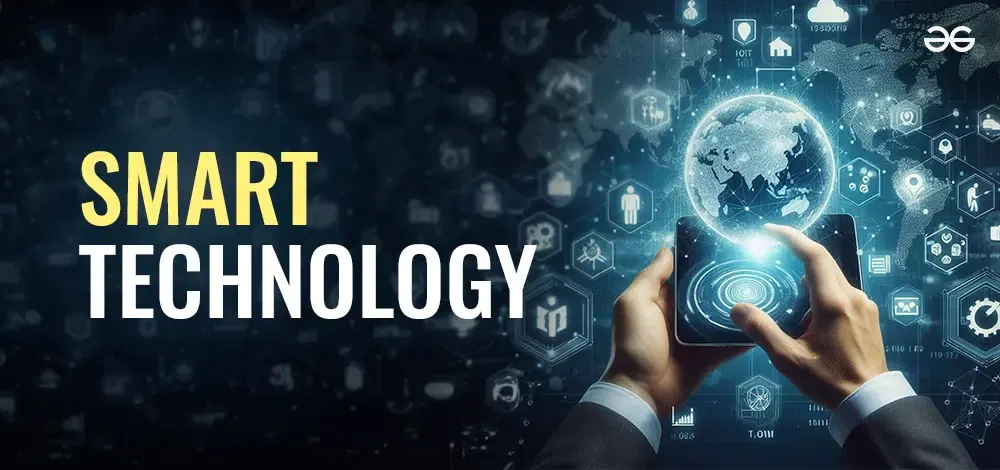
|
|
Smart technology includes devices, systems, and places that use advanced technologies to interact intelligently with people and other devices. These technologies use sensors, connections, and artificial intelligence (AI) to automate tasks, make things more convenient, and work more efficiently. They are found in smart homes, cities, wearable devices, and factories. Smart technology is changing everyday life by giving us new ways to connect and control things. This article explores how smart technology works, where it’s used, and how it helps us live and work better.  Smart Technology How Smart Technology WorksSmart technology works by combining advanced hardware and software to create systems and devices that can perform tasks automatically and learn from their interactions. Here’s a breakdown of how this technology functions: 1. Connectivity: Most smart devices are connected to the Internet, often referred to as being part of the Internet of Things (IoT). This connectivity allows them to send and receive data, which is essential for their operation. 2. Sensors: Smart devices are equipped with sensors that gather data from their environment. For example, a smart thermostat uses temperature sensors to adjust heating and cooling systems based on the room’s temperature. 3. Data Processing: The data collected by sensors are processed either locally on the device or sent to a central server or cloud to be analyzed. This processing enables the device to make informed decisions. 4. Machine Learning and AI: Many smart devices use machine learning algorithms and artificial intelligence to learn from data over time. This learning allows them to adapt to your habits and improve their functionality. For instance, a smart fridge might learn to recognize the types of groceries you store frequently and could suggest recipes based on what’s inside at any given time. 5. Automation and Control: After processing the data and making decisions, smart devices often automatically adjust their operations without human intervention. For example, smart lights can turn on or off based on the time of day or presence of people in the room. 6. User Interface: Smart devices typically have user-friendly interfaces that allow you to interact with them. This can be through physical buttons, touchscreen panels, mobile apps, or voice commands. By integrating these technologies, smart devices can perform a wide range of functions, from simplifying home tasks to enhancing security, improving energy efficiency, and much more. Examples of Smart TechnologySmart technology is all around us, making everyday tasks easier and more efficient. Here are some common examples: 1. Smartphones: These are mobile phones with advanced features like internet connectivity, apps, and voice assistants. 2. Smart TVs: Televisions that connect to the internet to stream videos, browse the web, and use apps. 3. Smart Home Devices –
4. Smartwatches: Wearable devices that track your fitness, send messages, and even make calls. 5. Smart Appliances –
Benefits of Smart TechnologySmart technology is making our lives easier by letting us do lots of tasks with little effort, like using voice commands to adjust room lighting, secure our homes, or order food online. It understands your preferences and adjusts its services for you personally. It even considers things like traffic or your car’s condition to help guide you safely. Here are some of its benefits – 1. Convenience: Artificial intelligence helps devices predict your needs and act on them without you having to do much. It’s changing how businesses operate and making everyday life easier. 2. Sustainability: With environmental concerns growing, both companies and homes are using smart technology to cut energy use. For example, it can turn off lights or adjust heating automatically which saves energy and money. 3. Security: Smart technology offers better security than old manual systems. Devices like security cameras and smart locks alert you to dangers and can even take steps to keep you safe, like locking doors automatically. 4. Efficiency: Smart devices collect data to find ways to improve. They learn from patterns to make systems more efficient, helping you start your day smoothly and get to work on time. 5. Saves Money and Time: Smart devices reduce energy bills by using less power and automate routine tasks, saving time that would otherwise be lost. ConclusionIn conclusion, smart technology is transforming how we live, work, and interact with our environment. It uses the Internet of Things (IoT), sensors, and artificial intelligence to make devices that can learn from us and act on their own. This technology brings convenience, increases security, boosts energy efficiency, and saves time and money. Whether it’s controlling your home temperature from your phone or getting traffic updates automatically, smart technology is making our daily lives easier and more connected. As it continues to evolve, we can expect even more innovative ways to integrate smart solutions into every aspect of our lives. What is Smart Technology? – FAQsWhat is the meaning of smart in technology?
What are examples of smart technology?
What is the meaning of Smarttech?
What is full form of SMART?
|
Reffered: https://www.geeksforgeeks.org
| GFG Wiki |
| Related |
|---|
| |
| |
| |
| |
| |
Type: | Geek |
Category: | Coding |
Sub Category: | Tutorial |
Uploaded by: | Admin |
Views: | 16 |